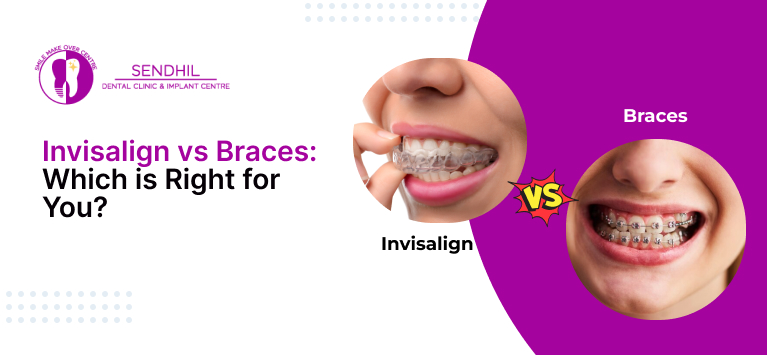
Invisalign vs Braces: Which is Right for You?
Achieving a straight, healthy smile is a common goal for many individuals. Two primary orthodontic treatments—Invisalign and traditional braces—offer effective solutions for teeth alignment. In this blog, we will explore the differences between Invisalign and braces, discussing aspects such as cost, treatment duration, effectiveness, and more. By the end, you’ll have a clearer understanding to help determine which option suits your needs best.
Table of Contents
What Is Invisalign?
Invisalign is an orthodontic treatment that utilizes a series of clear, removable aligners custom-made to fit snugly over your teeth. These aligners gradually shift your teeth into the desired position. Unlike traditional braces, Invisalign aligners are nearly invisible, offering a discreet alternative for teeth straightening. They are typically worn for 20–22 hours a day and are replaced every one to two weeks as your teeth move.
Advantages of Invisalign
- Aesthetics: The clear aligners are nearly invisible, making them an attractive option for individuals concerned about the appearance of traditional braces.
- Comfort: Without metal brackets or wires, Invisalign tends to be more comfortable, reducing the likelihood of mouth sores or irritation.
- Removability: Patients can remove the aligners for eating, drinking, brushing, and flossing, allowing for easier maintenance of oral hygiene and no dietary restrictions.
Disadvantages of Invisalign
- Discipline Required: Since aligners are removable, patients must be diligent in wearing them for the recommended 20-22 hours per day to ensure effective treatment.
- Not Suitable for Complex Cases: Invisalign may not be as effective for severe orthodontic issues that require more intricate tooth movements.
What Are Traditional Braces?
Traditional braces consist of metal brackets affixed to the teeth, connected by wires and elastic bands. The orthodontist periodically tightens the wires to exert pressure on the teeth, gradually moving them into the desired position. Braces are effective for correcting a wide range of dental issues, including complex misalignments and bite problems.
Advantages of Traditional Braces
- Effectiveness: Braces are highly effective for treating complex dental issues, including severe misalignments, overcrowding, and significant bite problems.
- No Discipline Required: Since braces are fixed, patients don’t need to remember to wear them, ensuring consistent treatment without relying on patient compliance.
Disadvantages of Traditional Braces
- Aesthetic Concerns: The metal appearance of braces is noticeable, which can be a concern for individuals seeking a more discreet option.
- Dietary Restrictions: Patients must avoid certain foods that can damage the braces, such as hard, sticky, or chewy items.
- Oral Hygiene Challenges: Cleaning around braces can be more challenging, increasing the risk of plaque buildup and potential dental issues if not maintained properly.
Invisalign vs Braces: Key Differences
Appearance and Aesthetics
One of the most notable differences between Invisalign and braces is their appearance. Invisalign aligners are clear and virtually invisible, making them a popular choice for individuals seeking a discreet treatment option. In contrast, traditional braces are more noticeable, though options like ceramic braces can be less conspicuous.
Comfort and Convenience
Invisalign aligners are made of smooth plastic, reducing the likelihood of irritation to the gums and cheeks. They are also removable, allowing for easier eating and oral hygiene. However, they require discipline, as they must be worn consistently to be effective. Traditional braces, while effective, can cause discomfort due to the metal components and may require dietary adjustments to avoid damaging the brackets.
Treatment Duration: Invisalign vs. Braces—Which Is Faster?
The duration of orthodontic treatment varies based on individual cases. In general, Invisalign treatment can take anywhere from 12 to 18 months, though mild cases may take less time. Traditional braces typically require 18 months to 3 years to achieve desired results. It’s essential to consult with an orthodontist to determine the expected treatment time for your specific situation.
Effectiveness: Is Invisalign Better Than Braces?
Both Invisalign and traditional braces are effective in treating various orthodontic issues. However, braces are often more suitable for complex cases involving severe misalignments or bite problems. Invisalign is typically recommended for mild to moderate alignment issues. An orthodontic evaluation is necessary to determine the most appropriate treatment for your needs.
Cost Comparison: Is Invisalign More Expensive Than Braces?
The cost of orthodontic treatment varies based on factors such as location, complexity, and duration. In general, Invisalign tends to be more expensive than traditional braces. However, costs can overlap depending on individual circumstances. It’s advisable to consult with your orthodontist and insurance provider to understand the financial implications of each option.
Maintenance and Oral Hygiene
Invisalign aligners are removable, allowing for easier cleaning of both the aligners and your teeth. This can lead to better overall oral hygiene during treatment. Traditional braces require meticulous cleaning around brackets and wires, which can be more challenging and time-consuming.
Cost of Braces vs Invisalign
When considering the cost of braces vs Invisalign, it’s important to factor in not only the initial expenses but also potential additional costs such as maintenance, repairs, and post-treatment retainers. Discussing payment plans and insurance coverage with your orthodontist can help make treatment more affordable.
How Long Does Invisalign Take vs Braces?
As mentioned earlier, Invisalign treatment typically ranges from 12 to 18 months, while traditional braces may take 18 months to 3 years. The exact duration depends on the complexity of the dental issues being addressed. Consistent wear of Invisalign aligners and adherence to your orthodontist’s instructions can influence treatment time.
What Does Invisalign Look Like?
Invisalign aligners are made of clear, BPA-free plastic, making them virtually invisible when worn. They are custom-made to fit snugly over your teeth, resembling thin, transparent mouthguards. This discreet appearance is a significant advantage for those concerned about the aesthetics of orthodontic treatment.
Is Invisalign Cheaper Than Braces?
In most cases, Invisalign is not cheaper than traditional braces. The advanced technology and customization involved in creating Invisalign aligners contribute to the higher cost. However, individual treatment costs can vary, so it’s essential to obtain detailed estimates from your orthodontist.
Are Braces Better Than Invisalign?
The effectiveness of braces vs Invisalign depends on the individual’s dental needs. Braces are generally more effective for complex orthodontic issues, while Invisalign offers a discreet and comfortable option for mild to moderate cases. Consulting with an orthodontist will help determine the most suitable treatment for you.
Difference Between Invisalign and Braces
| Feature | Invisalign | Braces |
| Appearance | Clear and nearly invisible | Visible metal or ceramic brackets |
| Comfort | Smooth plastic, less irritation | Can cause irritation due to metal wires |
| Treatment Duration | 12–18 months | 18 months–3 years |
| Cost | Generally higher | Usually more affordable |
| Effectiveness | Best for mild to moderate cases | Suitable for all cases, including severe misalignment |
| Maintenance | Easy to clean, removable | Requires extra care for cleaning |
Invisalign vs Braces: Which is Right for You?
Choosing between Invisalign and traditional braces depends on various factors, including the complexity of the dental issues, aesthetic preferences, budget, and lifestyle considerations. Consulting with an experienced orthodontist is crucial to determine the most suitable treatment option tailored to individual needs and goals.
Both Invisalign and traditional braces have their unique advantages and limitations. Understanding these differences can help in making an informed decision to achieve a healthy, beautiful smile.
Frequently Asked Questions
Invisalign typically takes 12–18 months, while braces can take 18 months–3 years. However, treatment time depends on individual cases and complexity.
Invisalign takes about 12–18 months, whereas braces usually take 18 months–3 years. Treatment duration varies based on alignment issues.
Invisalign is generally more expensive than braces due to advanced technology, but costs vary based on treatment complexity and location.
Invisalign is better for mild to moderate cases, while braces are more effective for severe misalignment. The choice depends on dental needs and lifestyle preferences.
Without insurance, Invisalign costs typically range from ₹2,50,000 to ₹6,50,000, depending on treatment complexity and provider.
Invisalign costs usually range from ₹2,50,000 to ₹6,50,000, influenced by factors like severity, location, and orthodontist fees.
Invisalign aligners are clear, thin, and nearly invisible plastic trays that fit snugly over your teeth.
In many cases, Invisalign is faster for mild to moderate issues, but braces work better for complex cases and may take longer.
Yes, Invisalign is typically more expensive than traditional braces due to its custom-made aligners and advanced technology.
Answer not available




